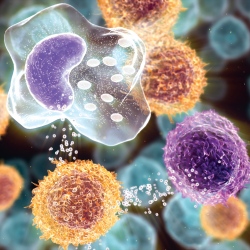
Researchers at Harvard University’s Wyss Institute for Biologically Inspired Engineering have developed a nanorobotic device made from DNA that could potentially seek out specific cell targets within a complex mixture of cell types and deliver important molecular instructions, such as telling cancer cells to self-destruct.
Inspired by the mechanics of the body’s own immune system, the technology might one day be used to program immune responses to treat various diseases.
Using the DNA origami method (complex 3-D shapes and objects are constructed by folding strands of DNA), the researchers created a nanosize robot in the form of an open barrel whose two halves are connected by a hinge.
Recognition molecules
The nanorobot’s DNA barrel acts as a container that can hold various types of contents, including specific molecules with encoded instructions that can interact with specific signaling receptors on cell surfaces, including disease markers.
The barrel is normally held shut by special DNA latches. But when the latches find their targets, they reconfigure, causing the two halves of the barrel to swing open and expose its contents, or payload.
